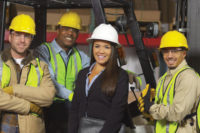This year’s National Safety Congress & Expo in San Diego (September 18-21, 2022) featured a tech hub of approximately 25 vendors that seemed a world away from the usual exhibits of PPE, training services and facility equipment.
On “planet safety technology” a different language is spoken. An incident management app is mobile ready to deliver digital solutions and make hand-written reports a thing of the past. You find repeated references to AI (artificial intelligence), VR (virtual reality), and AMRs (autonomous moving robots). Training is now “elearning” and it’s “self-paced” and “immersive.”
Sensors are everywhere on planet safety tech. They are, vendors say, comfortably worn on footwear, helmets, wrapped around biceps and wrists, tagged to clothing, worn by pedestrians and workers, divide facility space into safety zones and danger zones, create geofencing, and are built into powered industrial trucks, robots and road vehicles.
Metrics on planet safety tech are also out of the ordinary. A footwear “wearable” measures step count, gait speed, stride length, stride width stride time, swing time, calories burned, heel and toe clearance, and heel strike and toe off. These measures give you posture analysis, sit/static standing activity ratio, activity time, fall prediction, and symmetry left and right. All to produce “predictive analytics” – the risk of potential injuries.
On plant safety tech it’s claimed that “plug-and-play Internet of Things (IoT) technology” makes industries “safe, secure and efficient” by offering man-down alerts, incident worker “localization,” distance and contact tracing, proximity detection for collision avoidance, real-time feedback on driver behaviors, “no-go” and “must-go” zones, indoor maps, equipment usage versus idle times, site heatmaps, shop floor “spaghetti diagrams” and efficiency statistics for fleet sustainability.
Are employers and employees ready in 2022 to inhabit planet safety tech? Many are still learning the language, the metrics, the analytics and asking about the return on investment. Some are in pilot trials with wearables, apps and software. Large corporations with large EHS resources are more likely to be pioneers here. Surveillance capabilities on planet safety tech make some employees nervous if not resistant. AI enables video footage to be pulled from security cameras from any location, at any time, to check how teams are handling materials and processes. It’s the tech version of behavioral observations.
The eventually size of planet safety tech will depend on several factors: pricing, the business case for safety technology, privacy issues, and the attitudes of small and medium-sized employers. The benefits are many. Are they affordable?




